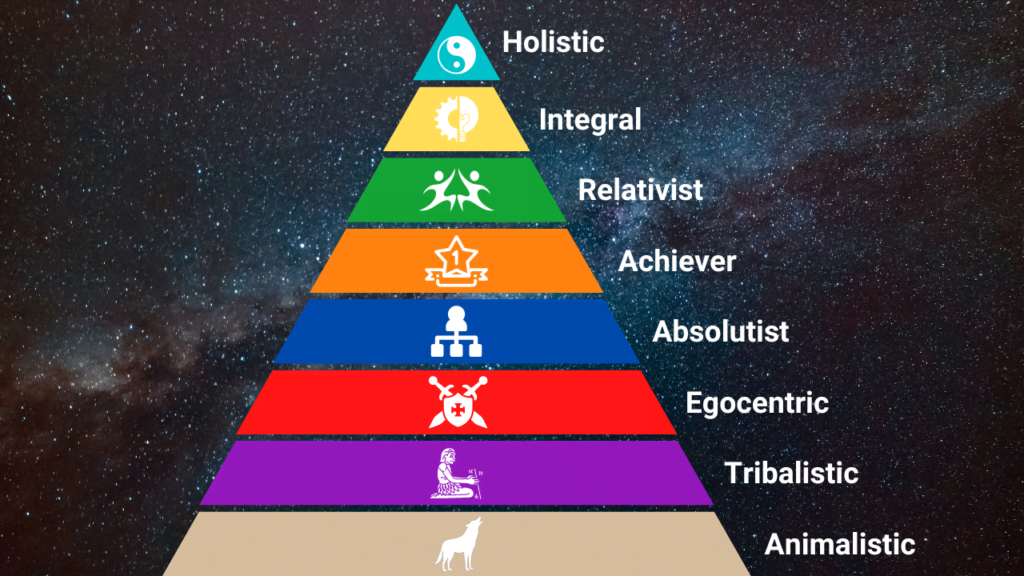Spiral Dynamics: What Stage Are You At? (Quiz)
Take the free spiral dynamics test below to find out what stage you’re at. Spiral Dynamics is a theory & model created by Clare Graves Ph.D. that describes an individual’s or community’s level of awareness and development. Spiral Dynamics is described by 8 distinct stages: Development of the individual follows this linear order. Stages cannot be skipped on the path of development. One must go through each stage in their development to reach the next. However, some individuals get stuck in certain stages for their whole life or will spend decades in a single stage. Learning what stage you’re in can help you look to the future of your development. It’s important to realize that most people have similarities to the stages just above and below them. If you feel like you identify with another stage more than your spiral dynamics test result, remember that it is a spectrum. For example your primary result may be stage orange, even though you hold some values from stage green and from stage blue. Tier 1 Value systems Stage Beige (Animalistic) Beige is purely concerned with survival. This is the stage that most life forms on this planet are at. It’s also where most babies and small toddlers fall on the spectrum. There is no concern for the collective during this stage, it is highly focused on meeting its own survival needs. If you are able to take this spiral dynamics test you are most definitely not at stage beige Learn more about stage beige here. Stage Purple (Tribalistic) Stage Purple marks a shift from individualism to collectivism. Instead of a concern for the survival of self, it has now morphed into the survival of the group. This stage values rituals and spirits. A sense of a higher power starts to form in stage purple, especially in the form of spirits. This stage is highly curious and views the world as magical and enchanting. Exploration begins in this stage as the fear of individual survival diminishes. Learn more about stage purple here. Stage Red (Egocentric) Stage Red marks a shift back to individualism with a self serving attitude. This stage is concerned with amassing power and status. Those in power take from those under them without guilt. Individuals in stage red are often aggressive, easily angered, and impulsive. Stage red is egocentric as the name implies and those in power believe they can get whatever they want through force. This stage is heavily linked to feudalism where a leader has power and those below him serve him. Stage red leaders can often be found leading a stage purple tribe. Learn more about stage red here. Stage Blue (Absolutist) The pendulum swings back towards collectivism in Stage Blue. The group once again becomes more important than the individual like in stage purple. However, in stage blue there is an established hierarchy with rules, morals, and procedures. There is an emphasis on precedent and tradition in this stage. Stage blue rejects violence and aggression and instead desires peace above all else. The increased care for individuals in the group leads to more peace. Individuals in this stage may be religious and entrenched in their own viewpoints. Because their morals are the highest priority, any new ideas that challenge their beliefs are viewed as threatening. Learn more about stage blue here. Stage Orange (Achiever) Stage orange is where the average American is located on the spiral dynamics spectrum. Stage orange is all about achievement, breaking barriers, and living up to your full potential. Conventional hierarchies found in stage blue are questioned here. Individuals pursue personal development during this stage. Stage orange individuals feel pressure to push themselves to be the best. Science and reason are born from and valued in stage orange. A free market capitalist system thrives under stage orange. You have this stage to thank for modern technology, inventions, and medicine. Stage orange is about pushing yourself and playing to win. Although this stage often leads to workaholism, over-attachment, and excessive consumerism. Learn more about stage orange here. Stage Green (Relativistic) This stage sees beyond the self and the group to view the world as a whole. The stereotypical hippie would quite likely be stage green. Stage green values diversity, new and conflicting ideas, and equality. People in stage green are often open minded and aren’t threatened by new perspectives. Stage green is associated with social democracies, social justice, liberalism, and activism. Many individuals in stage green may identify as vegetarians, LGBTQA+, or environmentalists. If you’re in stage green you most likely have a concern for the welfare of our planet and how it will turn out for future generations. Drawbacks to stage green include: excessive relativism, indecisiveness, and wanting to please everyone. Learn more about stage green here. Tier 2 Value systems Tier 1 value systems are externally focused as opposed to tier 2. Most of society is operating from tier 1. There is a greater sense of openness and complexity to tier 2 stages. The jump to tier 2 is a difficult jump because there are so few at these stages to guide you. Tier 2 value systems start to realize that real knowledge and truth can only come from deep inside. A great Tier 2 guide I have stumbled across is Leo Gura from Actualized.org, check him out if you’re looking for a good teacher. Stage Yellow (Integral) Stage Yellow enters a state of deep curiosity. There is a thirst for understanding and truth simply for the sake of itself in this stage. Systems thinking comes into play at this stage. Stage yellow individuals embrace paradox and understand it as a natural part of reality. This stage is about learning as much as possible and integrating it all together despite conflicting viewpoints. Stage yellow is all about big picture thinking on a deeper level than even stage green. A state of existential angst may arise in this stage. Stage green was more actively worried about the issues of the world


